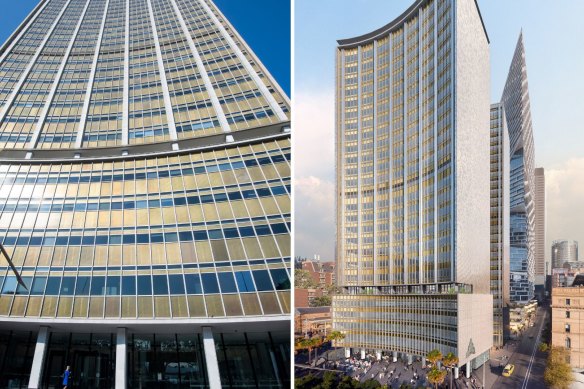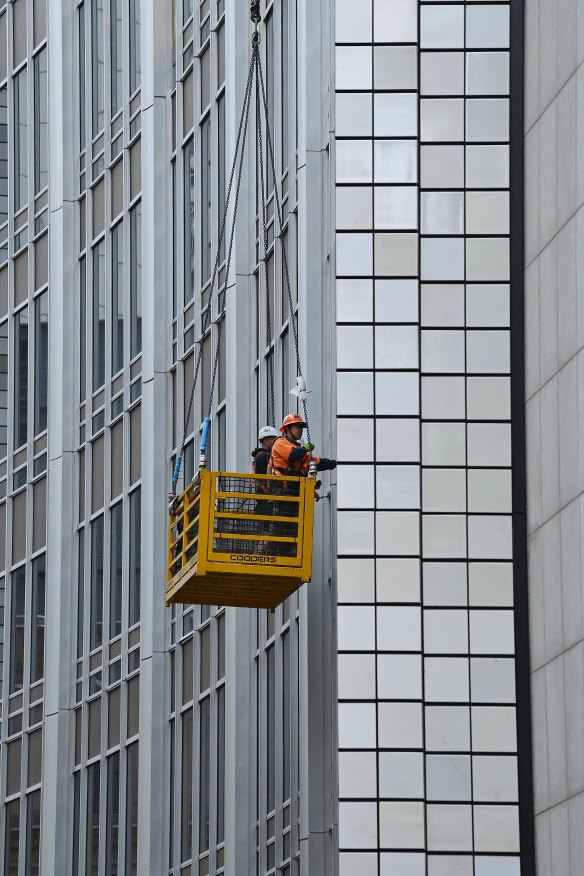- Exclusive
- Culture
- Art & design
- Architecture
$200m glow-up: Sydney’s first skyscraper gets a glittering makeover
By Linda Morris
When Sydney’s first high-rise tower opened in 1962, it boasted an automatic document conveyor system to deliver mail between floors, and a bank of lifts taking passengers at unheard-of speeds of more than 300 metres in one minute.
“The building was a symbol of a time when Australia was seeking to mark its place in the world,” said Matthew Morel, director of architects Johnson Pilton Walker (JPW).

Before and after renovations.Credit: Louise Kennerley and supplied rendered image.
“So many innovations we take for granted in building a skyscraper today. None of that existed then: building codes, safety standards – even the fire brigade was sceptical.”
The iconic former headquarters of AMP could have been demolished in Sydney’s rush to lift its skyline ever higher – instead the scaffolding is coming down on a $200 million refurbishment of Sydney’s grand old dame of city skyscrapers.
The last of 200 facade panels measuring 3.8 metres high and 1.2 metres wide are being craned in, and the building’s two flagpoles will be reinstated on the roof next month, signalling the final leg of a refurbishment 10 years in the making.
The careful attachment of 75,782 tiles – arrayed on more than 5000 panels – to the building’s monolithic wall ends is also nearing completion, the white tile-work giving the newly named 33 Alfred Street a lustrous sparkle in direct sunlight.
“The original mosaics were glittering and iridescent, really wonderful. One or two years later after the building opened, they started to fail and pop off and fall onto the street,” Morel said.
“Very quickly, the walls were reclad in very expedient, dull pebblecrete that was there for 50 years. We said, as part of the refurbishment, they should remove the pebblecrete and reinstate a reinterpretation of those original tile walls.”
The refurbished building is the final piece in the redevelopment of an entire city block on Sydney’s dress circle, Circular Quay, orchestrated by the City of Sydney.
The first was the upcycling of Quay Quarter Towers, an existing 1970s office block given a stunning new cantilevered skin, for which it won the World Building of the Year in 2022. Then came the restoration of laneways for restaurants, cafes and bars in association with the conservation of the old wool store Hinchcliff House.
During years of research into 33 Alfred Street, Morel’s team found only three examples of renovations to early modern glass and curtain wall buildings, all in the United States.
These included the United Nations’ Secretariat Building in New York, which was originally built with clear glass and had to be reglazed with reflective glass to manage overheating, and Lever House, the city’s first all-glass building.
“All those examples told us that there was room to improve the amenity for the building’s occupants, but it was important that we retain the original strong silver columns, the tartan patterning of the aluminium framing and the glittering gold glass panels,” Morel said.
“We set forth a process that was very rigorous and methodical because we knew that people loved this building, and we wanted to make sure its character was maintained.”
As a result of the many workshops convened with city planners, heritage advisors and engineers came the idea of taking the original window patterning and flipping it upside down.
The new configuration reinstates floor-to-ceiling views of Sydney Cove with a band of gold colour achieved at knee-length level in a strip of coloured mesh.

Inside the former AMP building, Sydney’s first skyscraper.Credit: Louise Kennerley
Glazes for the exterior wall tiles were developed specially by the Netherlands’ oldest ceramics company, Tichelaar, in consultation with the design team, through an extensive sampling and mock-up process to reinterpret the hues and iridescence of the original glass mosaic tiled walls.
“What ultimately the design has achieved is maximising natural daylight, with floor-to-window vision glass still respecting the gold tartan or gold spandrels along the slab edge,” said Nicholas Wilkinson, Dexus’s general manager of office development.
Dexus inherited the project when it acquired AMP Capital in March 2023, continuing the relationship with the project’s head contractor, Built.
The refurbished skyscraper is jointly owned by Dexus and Mirvac. Commercial tenants – mostly leading legal firms – are expected to move in by late 2025.
Wilkinson estimates the renovations shaved 20 to 30 per cent off the comparable cost of a rebuild.
Lord Mayor Clover Moore said the rejuvenation of the former AMP building was wonderful, thoughtful and sympathetic.

The scaffolding is coming down on a $200 million refurbishment of Sydney’s grand old dame of city skyscrapers.Credit: Kate Geraghty
“Construction is responsible for nearly 20 per cent of Australia’s carbon footprint, so limiting the impacts of demolition and construction is critical to reducing our emissions,” she said.
“By pursuing a refurbishment rather than a knockdown rebuild, AMP will have saved tons of carbon emissions.”
The NSW Heritage Council will decide this month whether to add the building to the state heritage register.
Find out the next TV, streaming series and movies to add to your must-sees. Get The Watchlist delivered every Thursday.